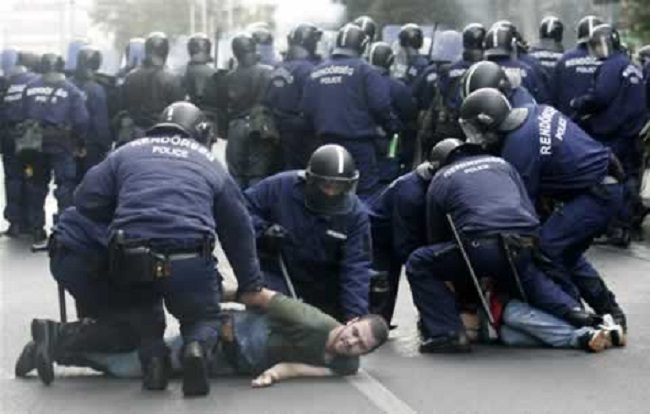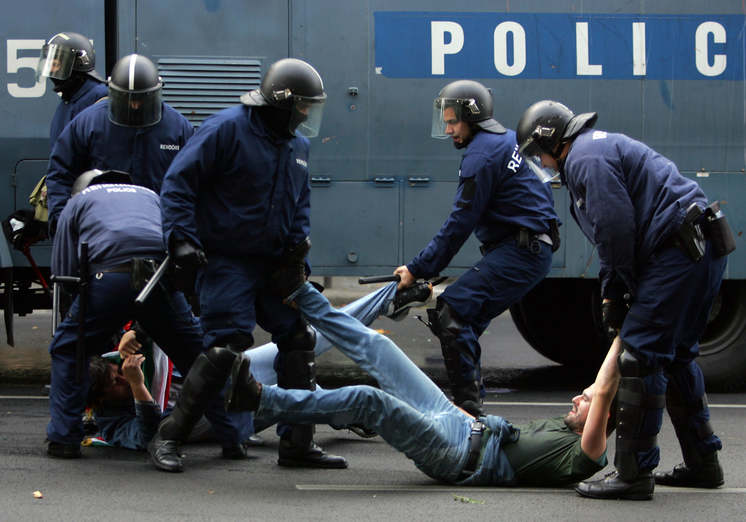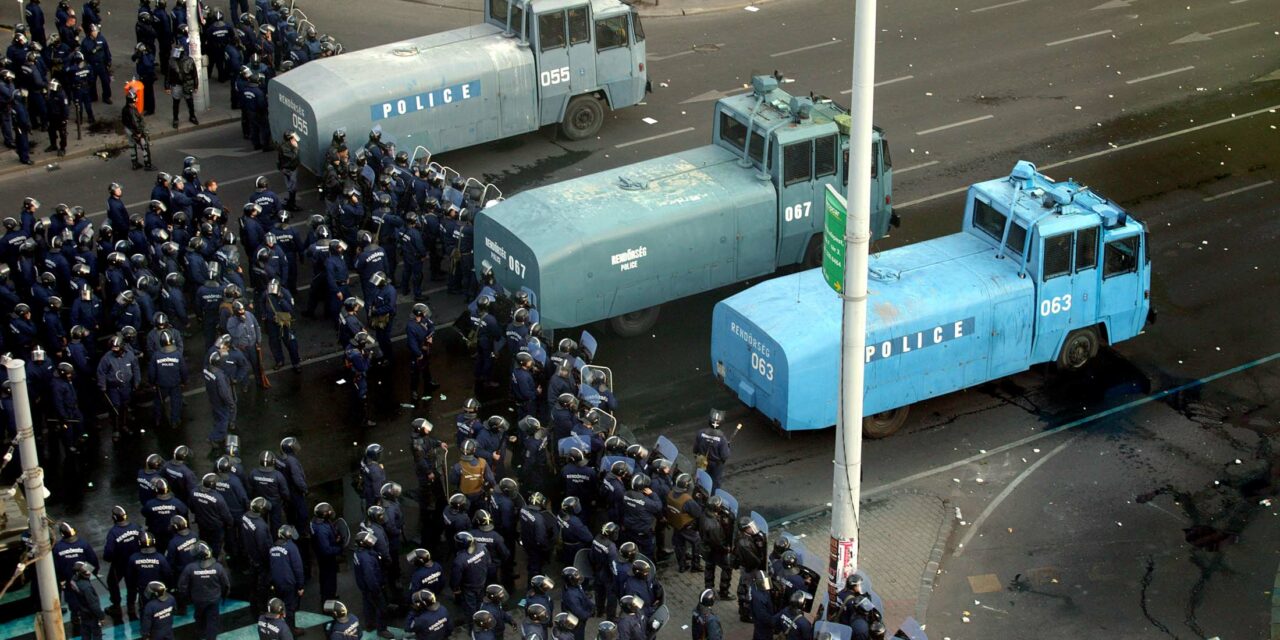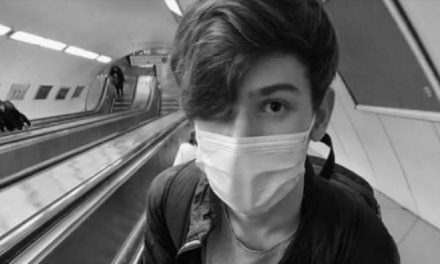The work of the Civil Justice Committee founded by CÖF-CÖKA (e.g. the analysis published on our portal by Tamás Fricz) basically presents the crimes committed during communism, which have not been investigated and thus remained without consequences, but about the most serious crime of the times after the regime change, the 2006 Gyurcsány terrorist attack they didn't forget me either. The analysis of constitutional lawyer Dr. Attila Magyar-Zsolnay presents the antecedents of the brutal police actions, the background of what happened then and the reasons for the lack of accountability.
The bloody violations of October 23, 2006
Péter Gergényi 's statements, it helped them a lot that the Prime Minister promised all support and help to the police to eliminate the clashes.
"According to the available information, the Budapest police chief was in regular telephone contact with the former prime minister during the events. In light of this, the possibility arises that the captain-general discussed and agreed with the prime minister about the events related to mass distribution.
The Civil Code According to Section 122(4), military crimes can only be committed by a person who is considered to be a soldier, but there is no obstacle to the criminal liability of a person who is not considered to be a soldier as an instigator or accomplice, in this case, for example, because the unlawful mass dispersal is primarily a civilian gave instructions (instigator) or supported it (psychic accomplice).
On the morning of October 23, 2006, in the Parliament, Ferenc Gyurcsány personally met with National Police Chief László Bene
The Prime Minister wrote in his blog the following day: "I was simply impressed by the professionalism with which the police did their work and protected me, a decent tax-paying citizen, it was running through my head, shouldn't I thank them somehow?" "
The police officers committed the brutal crimes without wearing identification numbers. The political state secretary of the Gyurcsány government, Ferenc Kondorosi , also believed that in a decent democracy, the responsible police leaders could not have remained in place after that.

Police terror on October 23, 2006 (photo: pestisracok.hu)
The next day Ferenc Gyurcsány , similar to the September events, praised the police. Ernő Gerő's speech from 1956, he stated that the police acted legally and correctly when they acted harshly against the rioting mob.
On September 17, 2010, Dr. László Bene presented to the committee that on October 23, 2006, Ferenc Gyurcsány on one occasion. As national police chief, Bene participated in the Kossuth Square ceremony, and was then invited to the Prime Minister's Office to go up to the Prime Minister's office. Here, Gyurcsány asked Bené that he wanted to participate in the inauguration of the 56th monument in Városliget, and whether Bene could guarantee the safety of the state leaders appearing at the inauguration.
While the TV reported minute by minute on the application of disproportionate police measures, the Prime Minister's speech cannot be interpreted in any other way than the political approval of all these measures.
In such a situation, half a sentence referring to excesses on the part of the prime minister would probably have been enough for a warning order to take proportionate measures to run through the hierarchy of the dispersal staff from the ORFK commander to the sergeant. However, the Prime Minister's interests were contrary to this.
On October 23, 2006, while the news broadcasts were constantly reporting on police excesses, Ferenc Gyurcsány's short statement on the public television newscast had the effect of reinforcing intentions, and even by suggesting "all means" he set expectations for the police: "The police not only have the right to decide how peace must be restored, but it is also his duty" . In several press statements, the Prime Minister admitted that he was in contact with the police leaders, who on October 23, 2006 gave orders for illegal dispersion.
Information also surfaced that in the fall of 2006, a central expectation within the police was to act against the demonstrators as violently as possible, using harsh means. The central instructions and expectations are hinted at by several police officers, such as the shotgun shooter who spoke on the May 13, 2021, broadcast of M1's Ma regleg program, but asked to remain anonymous.
Péter Gergényi's statements regarding October 23, 2006 , it can be established that Gyurcsány gave instructions to the police leaders and provided them with advice. In relation to Gyurcsány's statements, similar to the events in September, the possibility of his responsibility as a psychic's accomplice arises.
However, the report written by the István Balsai raising the Btk. also the possibility of a terrorist act according to
The Civil Code According to § 261, paragraph (1), point b), whoever, with the aim of intimidating the population, commits a violent, public danger, or weapon-related act against the person specified in paragraph (9), from ten to twenty years, or up to life is punishable by imprisonment. The Civil Code Paragraph (9) of § 261 includes, among other things, the following crimes: bodily harm, violent endangerment committed in the course of employment, violation of personal freedom.
As a result of a long process, the prime minister made the feeding of constant fear and danger a part of everyday life (e.g. the armed security of the government event in front of the National Museum on March 15, 2006, the blowing up of election rallies on March 28, 2006, the Fidesz rally on September 21, 2006 its postponement due to an alleged bomb plot.
On October 9, 2006, the Lajos Galambos , issued a statement stating that the mere passive presence of illegal acts taking place in public spaces corresponds to behavior that reinforces intent. Therefore, even a passive observer of mass riots has an intention-strengthening effect on the perpetrators of crimes, and this circumstance makes him a psychic accomplice to the basic crime.
The Parliamentary Commissioner for Citizens' Rights asked the Prime Minister to ensure that the bodies under his authority do not issue illegal announcements that exceed their authority in the future. The National Security Office was forced to withdraw the announcement.

Image: Reuters
What happened on October 23, 2006 in the center of Budapest was suitable for intimidating the population, because a realistic feeling of fear arose not only in the minds of those present in public spaces, but also in the minds of TV viewers. The residents of the capital simply did not dare to enter the city center, because the news reports reported one after another about the senseless and unprecedented abuse of people who were not participating in the demonstrations, who were passing by, or who were simply parking there. Some of them developed a fear of death, including those who fled from the raining rubber bullets and tear gas grenades into various doorways and inner building courtyards during the commemoration held in Astoria. In particular, we know from the testimony of the older, less mobile, and ill-health commemorators that they were overcome by panic, many of them had memories of the 56 shots, since those who experienced it feared that the events could escalate to the point of using live ammunition.
The act of violence does not need further explanation, there have been many final judgments that recorded that the police abused innocent people during their actions. There is also the case of "weapon-related crime", as criminal proceedings are also ongoing due to the fact that the policemen have caused serious bodily injury and more than once permanent disability with the fired rubber bullets. A firearm (hunting rifle) was used to fire the rubber bullets, on the other hand, the facts do not narrow down the crimes committed with a firearm, so the cases where the delict was committed with a rubber bullet rather than live ammunition can also be classified as having been committed with a weapon. The targeted and disproportionate use of rubber bullets, which are classified as having a much higher kinetic energy than allowed, exhausts the behavior of committing crimes related to weapons. Moreover, in my view, the key element for the realization of the crime is not the delimitation of rubber or live ammunition, but the ability to instill fear in the minds of the population that goes hand in hand with it. For laymen, the sight of hunting rifles and the gunshot wounds caused by them, as well as the sight of blood, was definitely enough to create a feeling of fear.
Criminal aiding and abetting (§ 244 of the Civil Code) is a classified case of up to five years of imprisonment if committed in connection with a terrorist act. Therefore, anyone who helps the perpetrator to escape from the persecution of the authorities, or tries to thwart the success of the criminal proceedings, can also commit this crime.
The prosecution of those politically responsible for the events of the fall of 2006, especially the then prime minister Ferenc Gyurcsány , the minister supervising the secret services, Lajos Galambos There is no evidence that would justify the prosecution of any of them, either as a criminal or as an instigator, and most likely will not be found in the future either. Based on indirect evidence (e.g. statements before the subcommittee) and logical conclusions, the National Legal Protection Service filed a complaint several times against not only Gergényi and the police officers who could be held responsible for the crimes of 2006, but also against Gyurcsány, Szilvásy and their associates. In order to prevent these crimes from becoming obsolete, the NJSZ filed repeated reports in several cases.
Hope can perhaps be given by an example from Romania, in which 25 years after the June 1990 mining raid aimed at intimidating the population of Bucharest, the Romanian Chief Prosecutor initiated criminal proceedings for crimes against humanity against the post-communist Romanian ex-president Ion Iliescu and the former head of the Romanian secret service, the SRI, Virgil Măgureanu and against other leading politicians. Between June 13 and 15, 1990, miners from the Zsil Valley ransacked the Romanian capital to "protect" the power of the then head of state, Ion Iliescu. The miners abused demonstrators, students and ordinary passers-by, ransacked the headquarters of the opposition parties. At least six people were killed and at least 1,000 were injured in the wave of violence known as the "Miner's Walk". In September 2014, the European Court of Human Rights (ECHR) decided that the Romanian law enforcement agencies are obliged to investigate the bloody acts of 1990, and also obliged the Romanian state to pay compensation. The military prosecutor's office questioned thousands of witnesses, but following a Constitutional Court decision, the mass of case files was handed over to civilian prosecutors, who closed the case without indictment in 2009. In September 2014, the ECtHR ordered the Romanian law enforcement agencies to proceed again, given that it can be established on the basis of evidence that Romanian state officials, including some members of the government, committed crimes against humanity.
In March 2015, the Romanian Supreme Court agreed to the reopening of the file, which had been closed without indictment. The prosecutors could thus initiate criminal proceedings against any of the suspects in the case, with regard to non-statutory crimes (crimes against humanity and intentional homicide). In the fall of 2015, military prosecutors continued the criminal prosecution on suspicion of crimes against humanity in the case of the violent suppression of the June 1990 University Square demonstration in Bucharest. Ion Iliescu and Virgil Magureanu , the first director of the Romanian Intelligence Service (SRI), founded in 1990, were suspected of crimes against humanity.... Due to the protracted proceedings, it is possible that several main defendants Béla Biszku , by the time the final conviction is handed down.
The question is, of course, whether there will be international will similar to Romania's. Will there be additional incriminating evidence regarding the fall of 2006? Will an independent judge or prosecutor, or perhaps the European Commission of Human Rights, have the courage to initiate criminal proceedings against Gyurcsány and his colleagues, similar to the 1990 Bucharest mining case?
(to be continued)
Author: Attila Magyar-Zsolnay, constitutional lawyer
(Cover image source: NJSZ)












